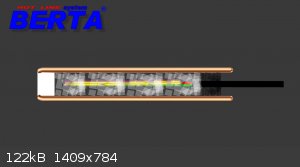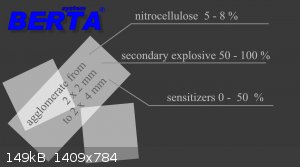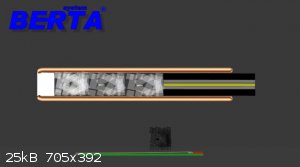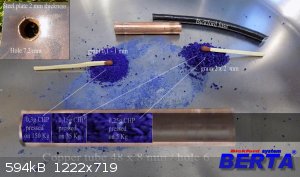| Pages:
1
..
42
43
44
45
46
..
78 |
kratomiter
Hazard to Others
  
Posts: 106
Registered: 30-9-2012
Member Is Offline
Mood: No Mood
|
|
@MineMan @Maker I used copper tubes because they're available where I live, but I'll try aluminum tubes if I find them. I didn't know the existence of
graphite tubes until now. As for glass, it's more difficult to work with it and also it can't handle high pressures to ensure that explosives like
TACP undergo DDT.
|
|
|
MineMan
National Hazard
   
Posts: 998
Registered: 29-3-2015
Member Is Offline
Mood: No Mood
|
|
Are you trying to make a DDT detonator? Yes, graphite from arrows. However, maybe the arrows are two small (about 6mm id) because 70mg of SADS keeps
on failing for me. I really hate approaching duds, even after waiting for a while...
|
|
|
Laboratory of Liptakov
International Hazard
    
Posts: 1335
Registered: 2-9-2014
Location: Technion Haifa
Member Is Offline
Mood: cool.gif
|
|
system Berta
In aluminium TACP worked, but only in diameter 8 mm. Wall 1mm Al. Again reccomend basic construction system Berta. Thus Copper, because is heavy.
During process DDT arises dynamic resistance of copper against increase pressure inside. Thus, not aluminium, glass, papper, plast and similarly. Only
copper, steel. It is system NPED. Required solid cavity. Always. Not softly shit. From the shit is impossible making any detonator NPED. Next:
TACP is not much sensitive. With wax very low sensitive. Therefore is use in system Berta. However pure TACP can have difficult DDT in diameter 6mm.
Therefore is better using CHP. It is TACP 88%, HMTA 6% NH4ClO4 6%. Mixing under a few drops NH4OH on porridge, get on surface 80 C and evaporate.
Arises soft material, partially crystals, partially as rubber. CHP worked in diameter only 4,3 mm. In copper cavity. General universal scheme is on
Vimeo or YT system Berta. Berta detonator is possible trashing blow help the hammer on the anvil. Without explode, of course. Not try it, everybody.
... ...Dr. ...Dr.


[Edited on 4-9-2016 by Laboratory of Liptakov]
Development of primarily - secondary substances CHP (2015) Lithex (2022) Brightelite (2023) Nitrocelite (2024)
|
|
|
MineMan
National Hazard
   
Posts: 998
Registered: 29-3-2015
Member Is Offline
Mood: No Mood
|
|
Ahh yes, thank you for the additional information LL, I was wondering how to convert TACP to CHP. Yes, I think that my TACP with 3% wax may just be
to insensitive for 6mm dia. I suspect no amount of SADS will do the job in that diameter with a thin (sub 1mm) graphite tube.
LL, I like fuses over electrical ignition, but it seems that for the Berta it must be ignited in the middle first, how is this possible with a fuse?
I am really impressed with TACP so far, small amounts can detonate ANNMAL and with small amounts of wax it is nearly immune to impact and friction (
it will still go off easily is placed on a rough rock and hit with a hammer, but steel on steel it is very resistant to blows). The best part, is no
acids and no neutralization and filtering!
LL, is HMTA Hexamine??
|
|
|
kratomiter
Hazard to Others
  
Posts: 106
Registered: 30-9-2012
Member Is Offline
Mood: No Mood
|
|
Interesting, I thought CHP was more insensitive than TACP, thanks for the info.
|
|
|
Laboratory of Liptakov
International Hazard
    
Posts: 1335
Registered: 2-9-2014
Location: Technion Haifa
Member Is Offline
Mood: cool.gif
|
|
CHP
HMTA = hexa methylen tetra amin. Hexamin. CHP - producing described here, thus on hot surface method, is very low sensitive on friction and pretty
low on hammer. Because is it soft material. MInimum hard crystals. At filling to cavity is it clearly feeling. Nothing sound at crushing. At pressing
is hear nothing. Similarly as at pressing the flour. Between fingers is feeling his soft consistence. The soft consistency is well made CHP. And
minimal risk with handle care. With Bickford fuse type is possible this. Diameter Bickford is usually 5,6 - 6 mmm. This making with CHP. Not confirmed
for others mixes. Dr.

[Edited on 5-9-2016 by Laboratory of Liptakov]
Development of primarily - secondary substances CHP (2015) Lithex (2022) Brightelite (2023) Nitrocelite (2024)
|
|
|
MineMan
National Hazard
   
Posts: 998
Registered: 29-3-2015
Member Is Offline
Mood: No Mood
|
|
Ok, but mirror ignition seems impossible with a fuse...Isn't the mirror ignition necessary for reliable DDT of CHP?
|
|
|
Laboratory of Liptakov
International Hazard
    
Posts: 1335
Registered: 2-9-2014
Location: Technion Haifa
Member Is Offline
Mood: cool.gif
|
|
Not. For CHP and Bickford fuse is posible use this scheme. Without mirror effect. Running it. Dr.
Development of primarily - secondary substances CHP (2015) Lithex (2022) Brightelite (2023) Nitrocelite (2024)
|
|
|
MineMan
National Hazard
   
Posts: 998
Registered: 29-3-2015
Member Is Offline
Mood: No Mood
|
|
Ahh good to know Dr. But different density loading is required I presume, a long with a strong metal case.
|
|
|
Laboratory of Liptakov
International Hazard
    
Posts: 1335
Registered: 2-9-2014
Location: Technion Haifa
Member Is Offline
Mood: cool.gif
|
|
system Berta - fuse type
All is described in scheme. Tube can be also steel. For classic Bickford fuse is best diameter of cavity 6 mm.

Dr.
Development of primarily - secondary substances CHP (2015) Lithex (2022) Brightelite (2023) Nitrocelite (2024)
|
|
|
Tricka90
Hazard to Self
 
Posts: 52
Registered: 14-8-2016
Member Is Offline
Mood: No Mood
|
|
Picric Acid Toxicity
The toxicity of Picric Acid is well known.
But is its toxicity a real concern even when dealing with very small quantities like one gram or two, for use just as a booster charge?
[Edited on 6-9-2016 by Tricka90]
|
|
|
greenlight
National Hazard
   
Posts: 705
Registered: 3-11-2014
Member Is Offline
Mood: Energetic
|
|
I wouldn't think so as long as you wear gloves and don't eat the stuff.
The most annoying thing when you make it occassionally is the yellow staining if you touch it or any of the solutions it was in contact with.
I found a pdf with some tests on the toxicity of trinitrophenol:
https://toxnet.nlm.nih.gov/cgi-bin/sis/search/a?dbs+hsdb:@te...
[Edited on 6-9-2016 by greenlight]
The only use for an atomic bomb is to keep somebody else from using one.
George Wald
|
|
|
Tricka90
Hazard to Self
 
Posts: 52
Registered: 14-8-2016
Member Is Offline
Mood: No Mood
|
|
Thank you greenlight, that was very interesting.
By the way, I'm a bit confused about picric acid ingredients when using aspirin. Two different recipies are found on the internet and in this forum.
According to the first one the ingredients should be aspirin, sulfuric acid and nitric acid, according to the second one ingredients should be
aspirin, ethyl alcohol, sulfuric acid and sodium/potassium nitrate.
Which recipie do you think is correct? Are they both effective?
|
|
|
Lotilko
Hazard to Self
 
Posts: 76
Registered: 9-6-2016
Member Is Offline
|
|
I am no expert on picric acid synthesis, but the first procedure should be the mixed acid nitration of aspirin whereas the second one uses sulfuric
acid and a nitrate salt. The ethanol is to remove any impurities from the aspirin, so you'll have pure acetylsalicylic acid. I think the second route
is more feasible for the amateur chemist because nitric acid is not a readily available reagent in some places.
|
|
|
greenlight
National Hazard
   
Posts: 705
Registered: 3-11-2014
Member Is Offline
Mood: Energetic
|
|
I have heard of both of those processes for the synthesis of TNP. Lotliko is right, the ethanol is needed in both of them to extract the
acetylsalicylic acid from the aspirin tablets.
In the potassium nitrate method, the nitric acid is formed in the flask during the nitration whereas the second method it is one of the reagents. I
prefer using the straight 70% nitric acid/98% sulfuric acid method as for me better yields are achieved.
[Edited on 7-9-2016 by greenlight]
The only use for an atomic bomb is to keep somebody else from using one.
George Wald
|
|
|
Tricka90
Hazard to Self
 
Posts: 52
Registered: 14-8-2016
Member Is Offline
Mood: No Mood
|
|
Thank you for all your help Lotilko and greenlight.
Greenlight, when making TNP with 70% nitric acid and 98% sulfuric acid do you prefer using phenol or aspirin (after reaction with ethanol to get
acetylsalicylic acid)?
|
|
|
greenlight
National Hazard
   
Posts: 705
Registered: 3-11-2014
Member Is Offline
Mood: Energetic
|
|
I have never made it straight from phenol as I never have had any...
I always used to make it from the cheap aspirin tablets but the straight phenol method would be exactly the same but a bit shorter as you don't have
to sulphonate the acetylsalicylic acid into phenol first.
The only use for an atomic bomb is to keep somebody else from using one.
George Wald
|
|
|
Gemlingur
Harmless

Posts: 9
Registered: 7-9-2016
Member Is Offline
Mood: No Mood
|
|
Amount of acid for nitroglycerin
I have often made nitroglycerim in the past, with varying success, and I was wondering hoe much glycering you can use per amount of acid mixtute? I
use oleum and 68% nitric acid so that i get 1:1 waterfree mixture. If i woulf use more concentrated oleum, might that get rid if the water that forms
when the glycerin gets nitratrated? And how much nitro can you make per amount of the acid mixture?
|
|
|
hissingnoise
International Hazard
    
Posts: 3940
Registered: 26-12-2002
Member Is Offline
Mood: Pulverulescent!
|
|
IIRC, the ratio is about 1 to 6 by wt.─ that is essentially anhydrous MA containing 40% HNO3!
|
|
|
Bert
|
Threads Merged
7-9-2016 at 05:32 |
Bert
Super Administrator
        
Posts: 2821
Registered: 12-3-2004
Member Is Offline
Mood: " I think we are all going to die. I think that love is an illusion. We are flawed, my darling".
|
|
Nitroglycerin and Nitroglycerin Explosives- Phokion Naoum
Go to the library and read. Ask short questions with no documentation of sources here, or in a related, existing thread in the future.
And where are you obtaining "oleum"?
Rapopart’s Rules for critical commentary:
1. Attempt to re-express your target’s position so clearly, vividly and fairly that your target says: “Thanks, I wish I’d thought of putting it
that way.”
2. List any points of agreement (especially if they are not matters of general or widespread agreement).
3. Mention anything you have learned from your target.
4. Only then are you permitted to say so much as a word of rebuttal or criticism.
Anatol Rapoport was a Russian-born American mathematical psychologist (1911-2007).
|
|
|
MineMan
National Hazard
   
Posts: 998
Registered: 29-3-2015
Member Is Offline
Mood: No Mood
|
|
Has anyone on this forum used dinitrogen pentoxide for nitration? Apparently it is the new thing, and industry is now using it as it provides higher
yields than HNO3 and can nitrate substances HNO3 is reactive towards.
I could not find any dinitrogen pentoxide for sale...
|
|
|
Lotilko
Hazard to Self
 
Posts: 76
Registered: 9-6-2016
Member Is Offline
|
|
One could prepare it from distilling a mixture of anhydrous nitric acid and phosphorus pentoxide under vacuum. The dinitrogen pentoxide is then
trapped in a condenser cooled with ice.
The reaction is:
2 HNO3 + P2O5 = N2O5 + 2 HPO3
[Edited on 2016.9.8 by Lotilko]
|
|
|
NeonPulse
Hazard to Others
  
Posts: 417
Registered: 29-6-2013
Location: The other end of the internet.
Member Is Offline
Mood: Isolated from Reality! For Real this time....
|
|
Quote: Originally posted by MineMan  | Has anyone on this forum used dinitrogen pentoxide for nitration? Apparently it is the new thing, and industry is now using it as it provides higher
yields than HNO3 and can nitrate substances HNO3 is reactive towards.
I could not find any dinitrogen pentoxide for sale... |
Yes I have. Recently too. I nitrated cellulose with WFNA and P2O5 and the dinitrogen pentoxide is formed in situ. It produced a very high quality NC
that burned extremely fast. It is the best NC I have ever made out of about 6 or so times I had made it. You will not find it for sale. The problem
was the mixture being so thick and possibly hygroscopic. The sulfuric acid is cheaper too.
And I don't think that the idea is new since it is published in COPAE and urbanski volumes. It is just not common and it's easier to use sulfuric
acid.!
|
|
|
Tricka90
Hazard to Self
 
Posts: 52
Registered: 14-8-2016
Member Is Offline
Mood: No Mood
|
|
Minimum Safe Distance
When handling high explosives, especially primaries, what precautions do you take in terms of maintaining a safe distance between your hands and the
energetic material, particularly when conducting dangerous procedures (testing, cap filling, etc...)? How do you evaluate the minimum safe distance
for a given power and quantity of an explosive?
In his writings, Ledgar gives the following rule:
| Quote: |
"10 centimeters per 1 gram TNT equivalent, 50 meters minimum safe distance per 500 grams TNT equivalent" |
Do you agree with that?
If the statement is correct my hand wouldn't get any permanent damage if 1 gram of let's say Silver Acetylide Double Salt detonates at a 10 cm
distance, because SADS it's way less powerful than TNT (of course I'm supposing it's not confined in any dangerous material such as glass). It looks
like a very tiny distance to me, what do you think about it?
Furthermore how would the rule applies to explosives with higher VOD than TNT such as ETN? I don't think there's a linear relationship between VOD and
minimum safe distance because pressure of the shock wave grows exponentially with VOD.
The subject is complicated so I'm just looking for a general rule of thumb. How do you organize in order to estimate and keep the proper distances
when dealing with EMs?
As for me I made all kinds of different tools (spatulas, pliers, spoons) which are long and made of wood (to reduce the risk of electrostatic
discharge). They allow me to always maintain a gap of 10 cm at least between my hand and SADS, which is the primary I've been experimenting with. I
always use them when dealing with relevant quantities of dry SADS (above 100 mg).
I still don't know how am I going to approach the handling of the more powerful (and still relatively sensitive) ETN.
p.s.
I know lots of EM enthusiasts tend to handle sensitive primaries with bare hand (as it can be seen even on YouTube). Maybe I'm too cautious but I
prefer to always work as safe as I can.
[Edited on 9-9-2016 by Tricka90]
|
|
|
XeonTheMGPony
International Hazard
    
Posts: 1636
Registered: 5-1-2016
Member Is Offline
Mood: No Mood
|
|
it is all math work, here is the pdf. Rule of thumb the further you are or the more stuff to absorb the energy the better.
when pressing caps I use dry towels wrapped around the press to absorb the shock wave and to dampen any shrapnel produced, cotton is a good acoustic
absorber.
Attachment: Blast Effect Calculation.pdf (155kB)
This file has been downloaded 431 times
|
|
|
| Pages:
1
..
42
43
44
45
46
..
78 |